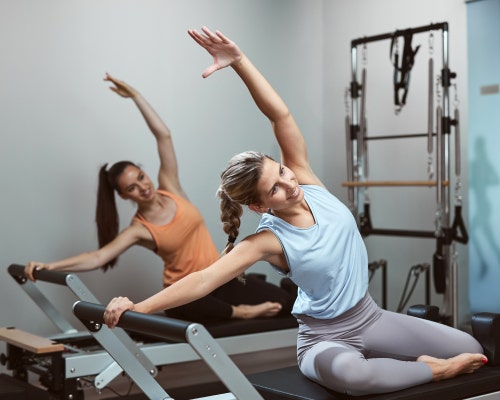How to Find the Best Fitness Classes For Your Needs
- 9/11/23


Avoid the dreaded workout routine rut by trying a group fitness class. Group fitness classes can be a fun way to be social and get fit. It's time to decide, what is the best fitness class for me?
In this article, we’ll explore the benefits and drawbacks of popular group fitness classes to help determine which class will be a good fit for you.
Best Fitness Class for Me
When choosing the best fitness class, it helps to begin with the end in mind, meaning focusing on your goal for each class. For example, some types of classes focus on flexibility while others target cardio or strength.
Another important consideration when choosing a class is the type of atmosphere and instructor that appeals to you. Each group fitness instructor brings a different feel to the class, so keep an open mind and don’t be afraid to “try out” different instructors until you find a good fit.
Regardless of your personal preference, the best group fitness classes promote a sense of community, while challenging you to reach your fitness goals. The sense of community and accomplishment you feel after each workout keeps you coming back each week.
Let’s explore the pros and cons of popular fitness classes to find the best fit for your workout routine.
High-Intensity Interval Training (HIIT)
CrossFit®, Burn Boot Camp®, and Orangetheory® Fitness are the three most popular high-intensity interval training (HIIT) group fitness classes. Each of these HIIT programs incorporates strength training with high-intensity cardio in a group setting with slight variations.
For example, CrossFit® incorporates powerlifting, Olympic lifting, and functional fitness. In comparison, Burn Boot Camp® and Orangetheory® Fitness offer more circuit training-style classes with some functional fitness.
Pros:
- Best for building strength
- Best for building muscle
- Burn a lot of calories in each workout session
Cons:
- Have to purchase a membership to an individual fitness center (or Box for CrossFit®) in order to do a workout
- Membership can be as expensive as a traditional gym membership
- Explosive movements used in HIIT training come with a higher risk of injury if not performed properly
Yoga
Yoga has been a top fitness trend for over 15 years. There are varying styles of yoga, but each style of yoga focuses on flexibility, breath control, muscular strength, and balance. One of the greatest benefits of yoga is that it is one of the fitness classes that any person, provided they can sit up unassisted, can try. There is truly a yoga class for everyone.
Pros:
- Best for improving flexibility and strengthening the core
- There is a yoga class for any fitness level
- You can find classes online, most fitness centers or private yoga studios
Cons:
- Attempting a class that is beyond your current fitness level carries an increased risk of injury
- Hot yoga may not be suitable for certain medical conditions
- Holding breath during poses causes an increase in blood pressure and may cause dizziness
Cycling
Programs like Spinning®, Les Mills’ RPMTM, and SoulCycle® continue to be the most popular indoor cycling group exercise classes. With energizing music and cardio-based workouts, indoor cycling classes offer a tremendous cardio workout. Even online classes, such as those offered by Peloton® foster an online community on their digital platform.
Pros:
- Best for improving cardio fitness
- Motivating music and different class styles can keep you energized
- You can find a cycling class in most major fitness centers
Cons:
- You may experience temporary muscle soreness at first from the bike saddle
- May need to use cycling shoes with special clips to provide an optimal cycling experience, but you can ride in sneakers
- Cycling focuses solely on the lower body muscles
Dance
Dance classes are choreographed aerobic fitness classes that can be a fun way to spice up any workout routine. Dancing is good for the body and has positive benefits for our brains as we age.
Learning new dance moves, especially in a social setting, helps memory, cognition, attention, and problem-solving. There are many types of dance classes such as Zumba®, ballroom, salsa, ballet, and line dancing.
Pros:
- Best for improving cardio and coordination
- Many different dance styles to fit your personal preference
- Dance moves your body in different ways than “traditional” cardio
Cons:
- Dancing is a skill that is a mental and physical challenge (which is also a good thing!)
- Having the right shoes matters. Invest in the appropriate type of shoe for each dance class to prevent potential injury
- Dance will improve cardio fitness, but not offer as many benefits for muscular strength
References:
-
Sperandei S, Vieira M, Reis A. Adherence to physical activity in an unsupervised setting: Explanatory variables for high attrition rates among fitness center members. Journal of Science and Medicine in Sport. 2016;19(11):916-920. doi: 10.1016/j.jsams.2015.12.522.
-
Maher J, Gottschall J, Conroy D. Perceptions of the activity, the social climate, and the self during group exercise classes regulate intrinsic satisfaction. Front Psychol. 2015;6. doi:0.3389/fpsyg.2015.01236.
-
Thompson, Walter R. Ph.D., FACSM. Worldwide Survey of Fitness Trends for 2022. ACSM's Health & Fitness Journal. 2022;26(1):11-20. doi:10.1249/FIT.0000000000000732.
-
Basso JC, Satyal MK, Rugh R. Dance on the Brain: Enhancing Intra- and Inter-Brain Synchrony. Front Hum Neurosci. 2021;14:584312. doi:10.3389/fnhum.2020.584312.





